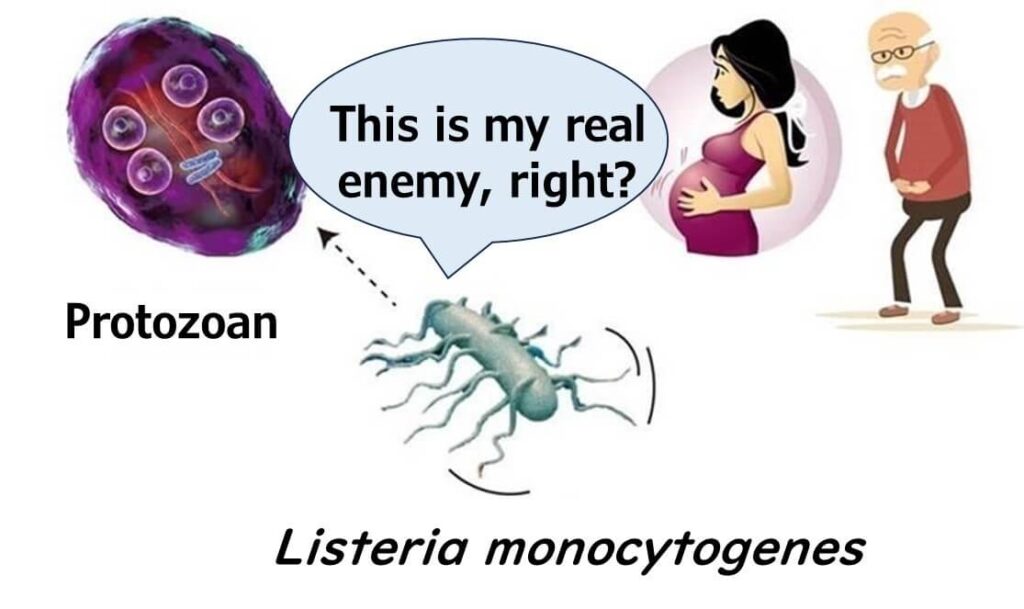When Listeria monocytogenes infect humans, they invade the epithelial cells of the intestines and cleverly evade immune responses, such as macrophage predation, by parasitising inside cells. This cunning infection mechanism leads to Listeria infections, which are particularly dangerous for pregnant women, causing miscarriages, and for the elderly, resulting in severe conditions like sepsis and meningitis. A critical factor in Listeria infection is Listeriolysin O (LLO). This article introduces research by Dr. Pushkareva and colleagues from the Russian Academy of Medical Sciences, which suggests that Listeriolysin O originally evolved in the natural ecosystem as part of a predator-prey relationship with the ciliate Tetrahymena.
Pushkareva and Ermolaeva
Listeria monocytogenes virulence factor Listeriolysin O favors bacterial growth in co-culture with the ciliate Tetrahymena pyriformis, causes protozoan encystment and promotes bacterial survival inside cysts
BMC Microbiology 2010, 10:26
This paper is available on PubMed Central (PMC).
In previous articles, we've explored research indicating that the pathogenic genes of bacteria like Vibrio and enterohaemorrhagic E. coli might have evolved for survival in the natural world. This article delves into the pathogenic genes of Listeria. An essential pathogenic gene in Listeria’s infection of mammals is Listeriolysin O (LLO), which is believed to play a role in intracellular survival and the induction of lymphocyte apoptosis during infection.
Ecological Role of Listeriolysin O: Overview of Dr. Pushkareva’s Experiments
Dr. Pushkareva's experiments proceeded as follows: when Listeria monocytogenes were introduced into a Tetrahymena culture, the ciliates initially preyed on the bacteria. However, over time, the Tetrahymena's trophozoites (nutrient cells) declined. This decline was due to two factors: the death of Tetrahymena cells and their transformation into cysts, a dormant form. By the 14th day of culture, all Tetrahymena trophozoites had disappeared, leaving only cysts. In contrast, in sterile cultures of Tetrahymena, all cells remained as active, swimming trophozoites.

Next, the researchers introduced a Listeria strain lacking the hly gene, which encodes Listeriolysin O, into the Tetrahymena culture. This strain did not cause Tetrahymena cell death or cyst formation, and the ciliates remained active in the culture. When the hly gene was reintroduced into the mutant strain, the same effects of cell death and cyst formation were observed. Additionally, transforming a non-pathogenic Listeria innocua strain with a plasmid expressing LLO resulted in Tetrahymena cyst formation.
These results suggest that Listeriolysin O likely evolved as a defence mechanism to protect Listeria from protozoan predation in its natural habitat, such as soil or the gastrointestinal tract of animals, long before it became a factor in human infection.
My Take on This Study

From my perspective, the key takeaway is that Listeriolysin O, a central virulence factor in Listeria monocytogenes, appears to have originally evolved not to infect humans, but to help the bacterium survive protozoan predators such as Tetrahymena. What struck me most in this study is how a molecule we typically associate with immune evasion and intracellular survival in mammals may, in fact, have much older ecological roots.
This challenges the conventional, human-centred framing often found in food microbiology education, where genes like hly are introduced solely in the context of pathogenesis. By recognising that these genes may have first arisen as survival strategies in microbial ecosystems—such as avoiding digestion by protozoa—we gain a more nuanced understanding of how "virulence factors" might reflect ecological versatility rather than aggression toward hosts.
As someone who has spent decades studying foodborne pathogens, I find this kind of ecological insight both humbling and intellectually refreshing. It reminds us that to truly understand bacterial behaviour—even in food environments—we must look beyond the clinical lens and consider the broader evolutionary forces at play.
For a basic overview of Listeria monocytogenes, please refer to the following article:
Listeria monocytogenes: Risks, Regulations, and Effective Control in Ready-to-Eat Foods

